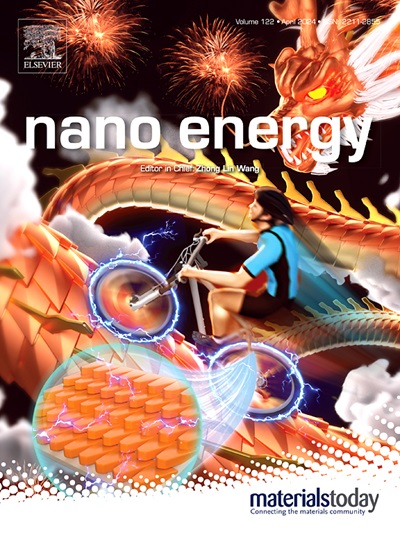Fully self-powered pipeline leakage detection and localization enabled by triboelectric nanogenerator
IF 16.8
1区 材料科学
Q1 CHEMISTRY, PHYSICAL
引用次数: 0
Abstract
An accurate and reliable leakage detection and localization system is essential for reducing resource waste and potentially hazardous incidents caused by leaks in industrial transportation pipelines. However, existing technologies often entail high implementation costs and reliance on external power sources, limiting their widespread industrial adoption. Here, we propose a cost-efficient, battery-free pipeline leakage detection device comprising a vibration-driven triboelectric nanogenerator (VD-TENG), an energy storage/release management circuit (EMC), and a wireless transmission module. The VD-TENG effectively harvests micro-vibrations from pipeline leaks into electricity, converting them into periodic pulse signals on the user interface via the EMC and wireless module, with the signal frequency determined by the vibration amplitude. The system accumulates a minimum electrical energy of 4.5 mJ to emit a pulse signal and demonstrates excellent stability. Ultimately, multiple integrated devices are uniformly deployed across the pipeline surface, forming a comprehensive sensing network. By leveraging the vibration attenuation characteristics along the pipeline, the leakage location can be accurately identified through analyzing the signal frequency relation among the devices. This work offers an alternative solution to the challenges in industrial pipeline leakage detection and location.

摩擦电纳米发电机实现全自供电管道泄漏检测和定位
一个准确可靠的泄漏检测和定位系统对于减少工业运输管道泄漏造成的资源浪费和潜在危险事件至关重要。然而,现有技术往往需要高昂的实施成本和对外部电源的依赖,限制了它们在工业上的广泛采用。在这里,我们提出了一种低成本、无电池的管道泄漏检测装置,该装置由振动驱动的摩擦纳米发电机(VD-TENG)、能量存储/释放管理电路(EMC)和无线传输模块组成。VD-TENG有效地收集管道泄漏的微振动转化为电能,通过EMC和无线模块将其转换为用户界面上的周期性脉冲信号,信号频率由振动幅值决定。该系统能积累4.5兆焦耳的最小电能来发射脉冲信号,并表现出优异的稳定性。最终,多个集成设备在管道表面均匀部署,形成一个完整的传感网络。利用管道沿程的振动衰减特性,通过分析各装置之间的信号频率关系,可以准确识别泄漏位置。这项工作为工业管道泄漏检测和定位的挑战提供了另一种解决方案。
本文章由计算机程序翻译,如有差异,请以英文原文为准。
求助全文
约1分钟内获得全文
求助全文
来源期刊

Nano Energy
CHEMISTRY, PHYSICAL-NANOSCIENCE & NANOTECHNOLOGY
CiteScore
30.30
自引率
7.40%
发文量
1207
审稿时长
23 days
期刊介绍:
Nano Energy is a multidisciplinary, rapid-publication forum of original peer-reviewed contributions on the science and engineering of nanomaterials and nanodevices used in all forms of energy harvesting, conversion, storage, utilization and policy. Through its mixture of articles, reviews, communications, research news, and information on key developments, Nano Energy provides a comprehensive coverage of this exciting and dynamic field which joins nanoscience and nanotechnology with energy science. The journal is relevant to all those who are interested in nanomaterials solutions to the energy problem.
Nano Energy publishes original experimental and theoretical research on all aspects of energy-related research which utilizes nanomaterials and nanotechnology. Manuscripts of four types are considered: review articles which inform readers of the latest research and advances in energy science; rapid communications which feature exciting research breakthroughs in the field; full-length articles which report comprehensive research developments; and news and opinions which comment on topical issues or express views on the developments in related fields.
 求助内容:
求助内容: 应助结果提醒方式:
应助结果提醒方式:


